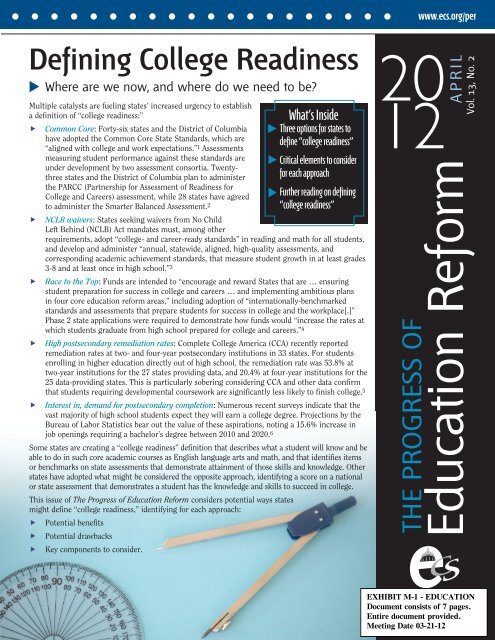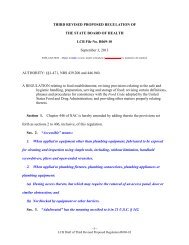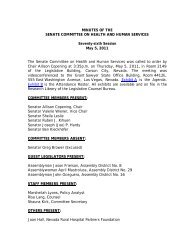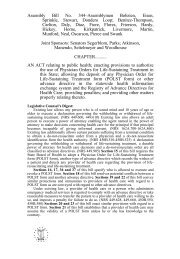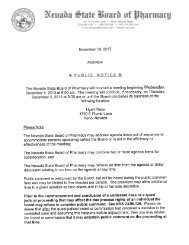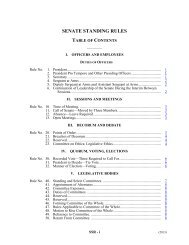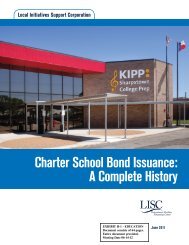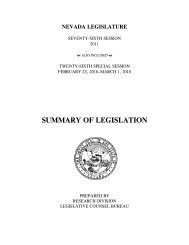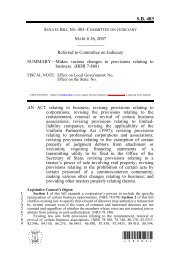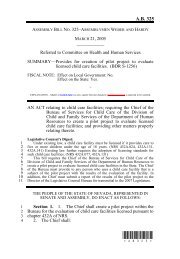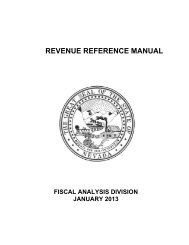Exhibit M-1
Exhibit M-1
Exhibit M-1
You also want an ePaper? Increase the reach of your titles
YUMPU automatically turns print PDFs into web optimized ePapers that Google loves.
1<br />
Defining College Readiness<br />
www.ecs.org/per<br />
20<br />
Where are we now, and where do we need to be?<br />
12<br />
What’s Inside<br />
Three options for states to<br />
define “college readiness”<br />
Critical elements to consider<br />
for each approach<br />
Multiple catalysts are fueling states’ increased urgency to establish<br />
a definition of “college readiness:”<br />
Common Core: Forty-six states and the District of Columbia<br />
have adopted the Common Core State Standards, which are<br />
“aligned with college and work expectations.” 1 Assessments<br />
measuring student performance against these standards are<br />
under development by two assessment consortia. Twentythree<br />
states and the District of Columbia plan to administer<br />
the PARCC (Partnership for Assessment of Readiness for<br />
College and Careers) assessment, while 28 states have agreed<br />
to administer the Smarter Balanced Assessment. 2<br />
NCLB waivers: States seeking waivers from No Child<br />
Left Behind (NCLB) Act mandates must, among other<br />
requirements, adopt “college- and career-ready standards” in reading and math for all students,<br />
and develop and administer “annual, statewide, aligned, high-quality assessments, and<br />
corresponding academic achievement standards, that measure student growth in at least grades<br />
3-8 and at least once in high school.” 3<br />
Race to the Top: Funds are intended to “encourage and reward States that are … ensuring<br />
student preparation for success in college and careers … and implementing ambitious plans<br />
in four core education reform areas,” including adoption of “internationally-benchmarked<br />
standards and assessments that prepare students for success in college and the workplace[.]”<br />
Phase 2 state applications were required to demonstrate how funds would “increase the rates at<br />
which students graduate from high school prepared for college and careers.” 4<br />
High postsecondary remediation rates: Complete College America (CCA) recently reported<br />
remediation rates at two- and four-year postsecondary institutions in 33 states. For students<br />
enrolling in higher education directly out of high school, the remediation rate was 53.8% at<br />
two-year institutions for the 27 states providing data, and 20.4% at four-year institutions for the<br />
25 data-providing states. This is particularly sobering considering CCA and other data confirm<br />
that students requiring developmental coursework are significantly less likely to finish college. 5<br />
Interest in, demand for postsecondary completion: Numerous recent surveys indicate that the<br />
vast majority of high school students expect they will earn a college degree. Projections by the<br />
Bureau of Labor Statistics bear out the value of these aspirations, noting a 15.6% increase in<br />
job openings requiring a bachelor’s degree between 2010 and 2020. 6<br />
Some states are creating a “college readiness” definition that describes what a student will know and be<br />
able to do in such core academic courses as English language arts and math, and that identifies items<br />
or benchmarks on state assessments that demonstrate attainment of those skills and knowledge. Other<br />
states have adopted what might be considered the opposite approach, identifying a score on a national<br />
or state assessment that demonstrates a student has the knowledge and skills to succeed in college.<br />
This issue of The Progress of Education Reform considers potential ways states<br />
might define “college readiness,” identifying for each approach:<br />
Potential benefits<br />
Potential drawbacks<br />
Key components to consider.<br />
Further reading on defining<br />
“college readiness”<br />
THE PROGRESS OF<br />
APRIL<br />
Vol. 13, No. 2<br />
Education Reform
2<br />
Option 1: Align Performance Expectations with State Standards<br />
www.ecs.org/per<br />
Some states have developed performance standards that describe what a student who is “college-ready” should know and be able<br />
to do in English language arts and math. These include states that have adopted the Common Core State Standards, as well as<br />
states such as Virginia and Texas, which have created their own standards and performance expectations.<br />
Potential benefits of using performance expectations aligned with state standards:<br />
Potential to create ongoing instructional focus on college-readiness. Well-honed performance expectations can help high<br />
school teachers target instruction and assignments to make college-readiness an ongoing focus, day after day throughout the<br />
academic year.<br />
Backmapping to the middle grades. Performance expectations can also help middle grades teachers understand what<br />
expectations lie ahead for their students when they enter high school, and help students be ready to take on those expectations.<br />
Bringing all stakeholders to the table. The process of articulating performance expectations can bring in the stakeholders<br />
who need to be at the table — high school and postsecondary instructors and state leadership, and potentially others<br />
(business leaders, for instance).<br />
Potential drawbacks of using performance expectations aligned with state standards:<br />
Vague expectations or those not linked to an agreed-upon, standard measuring stick are a waste of everyone’s time.<br />
Performance expectations might just as well not exist if they are either:<br />
1. Not reflected in a common, statewide assessment instrument or other standard means of measuring whether students<br />
have attained the measure<br />
2. Not worded clearly enough to ensure all teachers, students and parents know what is expected of students.<br />
Key policy considerations:<br />
Ensure that students have a common means to demonstrate attainment of skills. This may be through standards-based<br />
online assessments scattered across the high school grades and curriculum, or end-of-course exams, or standardized<br />
assessments administered in grades 9, 10 or 11. For instance, Colorado legislation enacted in 2008 directed the state<br />
board and the commission on higher education to “negotiate a consensus and adopt a description of postsecondary and<br />
workforce readiness.” The state board and commission must then “adopt one or more postsecondary and workforce planning<br />
assessments, postsecondary and workforce preparation assessments, and postsecondary and workforce readiness assessments”<br />
aligned with the description. 7<br />
100%<br />
90%<br />
80%<br />
70%<br />
60%<br />
50%<br />
40%<br />
30%<br />
20%<br />
10%<br />
0%<br />
86%<br />
Algebra I<br />
High Schools Offering Select Math and Science Courses<br />
84%<br />
Geometry<br />
84%<br />
Biology<br />
79%<br />
Algebra II<br />
73%<br />
Chemistry<br />
62%<br />
Physics<br />
50%<br />
Calculus<br />
Source: Civil Rights Data Collection, (Washington D.C.: Office for Civil Rights, U.S. Department of Education, March 2012),<br />
page 6, http://www2.ed.gov/about/offices/list/ocr/docs/crdc-2012-data-summary.pdf (accessed March 9, 2012).
3<br />
Source: David T. Conley, Educational Policy Improvement Center (EPIC), “What Does It Mean to Be College and Career<br />
Ready,” at Architecture for Implementing the Common Core Standards: Strategies, Partnerships, and Progress, slide 4<br />
(Louisville, KY, 2012), https://www.epiconline.org/files/pdf/20120228_SHEEO_ConleyHumphreys.pdf, (accessed March 8, 2012).<br />
www.ecs.org/per<br />
Identify skill subsets. Consider identifying subsets of skills that fall under the larger subjects of English language arts and<br />
math. For example, Virginia’s College and Career Ready English Performance Expectations specify 51 skills students need “to<br />
be academically prepared for success in entry-level, credit-bearing English courses in college or career training.” Reading,<br />
writing and communicating are articulated as three components, with subsets of skills identified for each of the three areas.<br />
Under writing, for instance, there are two “Documentation and Ethics” skills articulating that students should be able to use<br />
a standard method of documentation, and be able to define plagiarism and cite sources ethically. 8 Similarly, Virginia’s College<br />
and Career Ready Mathematics Performance Expectations set forth 36 mathematical functions and skills, grouped under<br />
“four interacting and overlapping strands that include content in the areas of algebra and functions, statistics, geometry,<br />
mathematical analysis, and trigonometry.” 9<br />
Ensure teachers “get” the expectations. Knowledge, skills and performance expectations for them should be thoroughly<br />
interwoven into secondary-level teacher preparation programs, and ongoing professional development and evaluation.<br />
Online tools such as diagnostic and formative assessments, classroom activities, assignments, etc. should be available to help<br />
teachers help students work towards achieving the standards, starting in grade 9.<br />
Ensure remediation (if necessary) prior to high school graduation. Texas, for example, has integrated college-ready<br />
standards into end-of-course assessments, and requires high school seniors who fall short of college readiness standards on<br />
an end-of-course exam to “enroll in a corresponding content-area college preparatory course[.]” 10 Legislation directs the<br />
commissioner of education and the commissioner of higher education to jointly develop essential knowledge and skills for<br />
college preparatory courses in English language arts, math, science and social studies, as well as end-of-course assessments<br />
for each college preparatory course. 11<br />
Include “behaviors.” College-ready knowledge and skills, and performance expectations for them, should express not just<br />
academic knowledge and skills, but also David Conley’s other “dimensions of college and career readiness” — such as<br />
“contextual skills and awareness”, “academic behaviors” and “key cognitive strategies” — that are so critical to college<br />
success. 12 For example, Colorado’s Postsecondary and Workforce Readiness Description includes “Learning and Behavior<br />
Skills” in nine areas. One of these areas, “Work Ethic,” includes seven skills, such as “Manage time effectively” and “Plan and<br />
prioritize goals.” 13
4<br />
Option 2: Establish ambitious cut scores on state assessments<br />
www.ecs.org/per<br />
Such scores on state assessments could reflect a level of competence that indicates a high likelihood of success in college-level<br />
coursework.<br />
Potential benefits of setting ambitious cut scores<br />
on state assessments:<br />
(Presumably) testing what students have been taught.<br />
State assessments are aligned to state standards and in<br />
the majority of states, will be aligned to the Common<br />
Core. Identifying college-ready students using a<br />
measure of what students should be exposed to in the<br />
curriculum makes sense.<br />
Encouraging students to take state tests seriously.<br />
Since the advent of statewide assessment and<br />
accountability systems in the 1990s — and perhaps<br />
since the advent of computer-scored testing — reports<br />
have eddied about students not taking assessments<br />
seriously. Sending the message that state assessments<br />
“count” as a determinant of whether a person is<br />
college-ready may make high school students take state<br />
assessments more seriously.<br />
One test, multiple purposes. States are already administering assessments to all students for purposes of state and federal<br />
accountability. Using such tests as a gauge of whether students are prepared for college creates efficiencies in terms of time<br />
and money.<br />
Support from research. Geiser’s 2008 analysis of nearly 125,000 University of California entrants between 1996 and 2001<br />
cites multiple advantages of using state assessments to “signal” college readiness, over use of an assessment such as the SAT,<br />
which is intended to predict students’ likelihood of postsecondary success:<br />
• Achievement tests help reinforce the teaching and learning of a rigorous academic curriculum.<br />
• Achievement tests serve an important diagnostic function ... [providing] feedback on the specific areas of the curriculum<br />
where the student is strongest and weakest.<br />
• Most important is the message that achievement tests convey to students. A low SAT score sends the message to students<br />
that their performance reflects a lack of ability, rather than factors such as unequal access to good schools and welltrained<br />
teachers. … A low score on an achievement test means simply that the student has not mastered the specific<br />
content. This may be due to any number of factors, including inadequate instructional resources , inferior teaching – or<br />
lack of hard work on the part of the student. Achievement tests focus attention on determinants of performance that are<br />
alterable, in principle, and are thus better suited to the needs of educational improvement and reform. 14<br />
Potential drawbacks of setting ambitious cut scores on state assessments:<br />
Benchmarking to high standards essential. Assessments not fully benchmarked to world-class expectations might provide a<br />
false sense of competence.<br />
A test taken once shouldn’t create a make-or-break situation. State assessments are a single snapshot in time, and everybody<br />
has an off day.<br />
Key policy considerations:<br />
Students have high expectations for college,<br />
and these expectations have increased<br />
over the past two decades. In 1988, 57%<br />
of middle and high school students said it<br />
was very likely they would go to college.<br />
By 1997, this level had increased to 67%.<br />
Today, 75% say it is very likely they will go<br />
to college.<br />
Source: The Metlife Survey of the American Teacher: Preparing Students for<br />
College and Careers. (May 2011). Accessed March 8, 2012, from http://www.metlife.<br />
com/assets/cao/contributions/foundation/american-teacher/MetLife_Teacher_Survey_2010.pdf.<br />
Timing is everything. Pre-college remediation is critical. Assessments should be administered early enough in high school<br />
that ample time is available to provide sufficient remediation to students in need. Florida has set thresholds on the reading<br />
portion of the grade 10 FCAT and on the Algebra I and geometry end-of-course assessments that are required for high school<br />
graduation. High schools are required to evaluate every student’s college readiness using results from the corresponding<br />
component of the common placement test, or from an equivalent test identified by the state board. High schools must then<br />
use the test results to identify and require students needing remediation to “complete appropriate postsecondary preparatory<br />
instruction prior to high school graduation.” 15
5<br />
Option 3: Use traditional college admissions or placement tests<br />
www.ecs.org/per<br />
Setting a “college-ready” cut score on the English or math subsections of the ACT or SAT, or on national or state-developed college<br />
placement exams, is one approach states have taken to define college-readiness. Cut scores on college placement exams are almost<br />
universally used by two- and four-year postsecondary institutions to identify students in need of developmental education, but have<br />
been criticized by many observers as a tripwire unknown to the vast majority of college entrants, who are unaware that low scores<br />
on such exams could require them to complete (and pay for) remedial education before enrollment in credit-bearing coursework.<br />
Potential benefits of using ACT and SAT scores:<br />
Well-known. ACT and SAT are “known quantities” on which acceptable scores signal “college-readiness.” Defining college<br />
readiness by cut scores on well-known assessments that most four-year college applicants (and some two-year applicants)<br />
already take eliminates the “gotcha” factor that placement exams can create.<br />
More students taking ACT, SAT. States are increasingly requiring all students to take the ACT or SAT, thereby eliminating<br />
the possibility that less well-informed students (or students who intend to enroll in a community college) will choose not<br />
to take these exams. At least 12 states require all high school juniors to take the ACT or SAT, with additional states piloting<br />
district-level efforts or anticipated to adopt ACT/SAT-for-all.<br />
Opportunity to remediate early. Assessments administered well before college entry, such as SAT’s PSAT or ACT’s EXPLORE<br />
in 8th and 9th grade, and PLAN in 10th grade, can identify students at risk of not meeting college-readiness benchmarks<br />
while there’s still time to provide remediation before students sit for the ACT or SAT in 11th or 12th grade.<br />
Percentage of ACT test-taking population meeting college readiness benchmark scores, by subject:<br />
Academic years 1996–97 through 2009–10<br />
Percent<br />
100<br />
80<br />
40<br />
40<br />
20<br />
0<br />
English<br />
Reading<br />
Mathematics<br />
Science<br />
1996-97 1998-99 2000-01 2002-03 2004-05 2006-07 2008-09 2009-10<br />
Academic year<br />
Note: College readiness benchmark scores are based on the actual performance of approximately 90,000 college students from a nationally<br />
representative sample of 98 institutions and represent the level of achievement required for students to have a 50 percent chance of obtaining<br />
a B or higher or about a 75 percent chance of obtaining a C or higher in corresponding credit-bearing first-year college courses. These college<br />
courses include English Composition, College Algebra, an introductory social science course, and Biology. The Benchmarks are median course<br />
placement values for these institutions and as such represent a typical set of expectations. The benchmark scores, out of a total possible score of<br />
36, are 18 for English, 21 for Reading, 22 for Mathematics, and 24 for Science. Estimates are based on all students who took the ACT assessment<br />
during their sophomore, junior, or senior year and who graduated from high school in the spring of the respective year shown. Beginning<br />
in 2001–02, some states mandated participation in ACT testing for all high school seniors. Prior to that year, the test would have been taken<br />
primarily by those students who planned on attending college.<br />
Source: American College Testing Program, ACT National Scores Report, 1996–2010.<br />
Table Source: S. Aud, A. KewalRamani and L. Frohlich, America’s Youth: Transitions to Adulthood (NCES 2012-026). (U.S. Department of<br />
Education, National Center for Education Statistics. Washington, DC: U.S. Government Printing Office, 2011), page 45,<br />
http://nces.ed.gov/pubs2012/2012026.pdf (accessed March 8, 2012).
6<br />
Potential drawbacks of using ACT and SAT scores:<br />
Senior year without rigorous English and math may negate scores. Many students take<br />
the ACT or SAT in 11th grade. Those who earn “college-ready” scores at that time but who<br />
do not take rigorous English or math coursework during their senior year of high school<br />
may have forgotten too much to be successful in entry-level courses by the time they reach<br />
their first semester of college.<br />
Not all ACT subtests have equal predictive power, some research suggests. Some research<br />
has drawn into question the ACT Reading subtest’s ability to predict college success. The<br />
authors of a 2011 study posit, “In fact … Reading and Science [subtest scores] provide<br />
essentially no predictive power regarding college outcomes.” (The same study found<br />
the ACT English and Mathematics subtests to be “highly predictive of positive college<br />
outcomes[.]”) 16<br />
SAT may have greater negative impact on low-income and students of color. SAT critics<br />
cite research that the test — intended to “predict” students’ likelihood of college success<br />
based on measures of capacity to learn, rather than test students’ knowledge of academic<br />
subjects — is less predictive of the success of low-income and minority students. Saul<br />
Geiser of UC Berkeley’s Center for Studies in Higher Education notes, “As an admissions<br />
criterion, the SAT has a more adverse impact on poor and minority applicants than highschool<br />
grades, class rank, and other measures of academic achievement; admissions criteria<br />
that emphasize demonstrated achievement over potential ability are more likely to promote<br />
educational equity.” 17<br />
Key policy considerations:<br />
Consider subtest scores rather than composite score. While most public universities use ACT<br />
or SAT composite scores in making admissions determinations, composite scores can mask<br />
low scores in English or math that indicate a lack of college-readiness.<br />
Include the Writing section of either ACT or SAT.<br />
Consider differential cut scores. For example, Kentucky’s college readiness indicators<br />
define cut scores on ACT, SAT, COMPASS and KYOTE (Kentucky Online Testing) math<br />
subtests. However, the state sets differential college-ready scores based on whether students<br />
are entering liberal arts courses, college algebra or calculus. 18<br />
Require four years of math, including math during senior year of high school. As noted<br />
earlier, students who perform well on an assessment but who do not enroll in challenging<br />
coursework in that subject the following academic year may not be truly “college-ready”<br />
by the time they reach college. States are increasingly raising graduation requirements to<br />
include four years of math, and more states are beginning to specify that a math course<br />
must be taken each year of high school, to close loopholes for students who earn high<br />
school math credit before grade 9.<br />
Require remediation for students who do not meet college-readiness thresholds.<br />
Kentucky’s graduation requirements note, “If a student does not meet the college readiness<br />
benchmarks for mathematics … the student shall take a mathematics transitional course<br />
or intervention, which is monitored to address remediation needs, before exiting high<br />
school[.]” 19<br />
Set an expiration date on using assessment results. Kentucky provides, “A COMPASS or<br />
KYOTE placement test score will be guaranteed as an indicator of college readiness for 12<br />
months from the date the placement exam is administered.”<br />
Conclusion<br />
This short report by no means addresses all the possible means to ensure students’ collegereadiness,<br />
and is not intended to provide an exhaustive set of benefits, drawbacks and policy<br />
considerations for each approach. Yet a few key points are clear:<br />
We’re not there yet. Many states are still working to define college readiness.<br />
It’s a work in progress. States that have established college readiness definitions should<br />
regularly revisit them to ensure the highest rigor, feasibility and fidelity to implementation.<br />
www.ecs.org/per<br />
ECS Resources<br />
Recent State Policies/Activities:<br />
College-Readiness<br />
Summaries and links to newly enrolled or<br />
enacted legislation and recently approved<br />
state board rules from across the states.<br />
Updated weekly.<br />
http://www.ecs.org/ecs/ecscat.nsf/<br />
WebTopicView?OpenView&count=-<br />
1&RestrictToCategory=High+School--<br />
College+Readiness<br />
P-20 Blog<br />
ECS’ P-20 blog reports on state policy<br />
activity and research on improving<br />
student transitions across the P-20<br />
pipeline, including improving college<br />
readiness.<br />
http://p-20matters.blogspot.com/<br />
At ECS’ 2012 National Forum on<br />
Education Policy!<br />
The author of this issue of The Progress<br />
of Education Reform will lead the July<br />
11 session, “Defining College Readiness:<br />
Where Are We Now? Where Do We<br />
Go from Here?” and will provide the<br />
current landscape of state-level collegereadiness<br />
definitions, discuss potential<br />
benefits and challenges of various aspects<br />
of definitions, and propose next steps<br />
for states to ensure greater numbers of<br />
students complete high school ready for<br />
postsecondary education.<br />
http://www.ecs.org/html/meetings.asp<br />
Other Recommended<br />
Resources<br />
Reaching the Goal: The<br />
Applicability and Importance of the<br />
Common Core State Standards to<br />
College and Career Readiness<br />
Examines the degree to which the<br />
knowledge and skills contained in<br />
the Common Core State Standards<br />
are applicable to and important for<br />
postsecondary readiness.<br />
https://www.epiconline.org/files/pdf/<br />
ReachingtheGoal-FullReport.pdf
7<br />
Endnotes<br />
1 Common Core State Standards Initiative, About the Standards, http://www.corestandards.org/about-the-standards,<br />
(accessed March 8, 2012).<br />
2 Partnership for Assessment of Readiness for College and Careers, PARCC States, http://www.parcconline.org/parcc-states,<br />
(accessed February 23, 2012); Smarter Balanced Assessment Consortium, Member States,<br />
http://www.smarterbalanced.org/about/member-states/, (accessed February 23, 2012).<br />
3 U.S. Department of Education, ESEA Flexibility (Washington, D.C.: U.S. Department of Education,<br />
September 23, 2011), http://www.ed.gov/esea/flexibility/documents/esea-flexibility.doc, (accessed February 23, 2012).<br />
4 “Department of Education: 34 CFR Subtitle B, Chapter II [Docket ID ED–2009–OESE–0006] RIN 1810–AB07<br />
Race to the Top Fund,” 74 Federal Register 221, (November 18, 2009), pp. 59688-59834; “Department of<br />
Education: Overview Information; Race to the Top Fund; Notice Inviting Applications for New Awards for<br />
Fiscal Year (FY) 2010,” 75 Federal Register 71, (April 14, 2010), pp. 19496-19531.<br />
5 Complete College America, Time Is the Enemy, (September 2011), http://www.completecollege.org/docs/Time_Is_the_<br />
Enemy.pdf, (accessed February 23, 2012); ECS Research Studies database, FAQ: “Dev. Studies/Remedial Ed.:<br />
What role does and can it play in college completion?” (n.d.), http://www.ecs.org/rs/SearchEngine/SearchResults.aspx?faq_<br />
id=a0870000003JEnGAAW, (accessed March 1, 2012).<br />
6 Bureau of Labor Statistics, Employment Projections, “Employment by summary education and training<br />
assignment, 2010 and projected 2020,” (last modified February 1, 2012),<br />
http://www.bls.gov/emp/ep_table_education_summary.htm, (accessed February 23, 2012).<br />
7 colo. rev. stat. § 22-7-1008((1)(a) and (2)(a)<br />
8 Virginia Department of Education, Virginia’s College and Career Ready English Performance Expectations<br />
(n.d.), http://www.doe.virginia.gov/instruction/college_career_readiness/expectations/perf_expectations_english.pdf, (accessed March 2,<br />
2012).<br />
9 Virginia Department of Education, Virginia’s College and Career Ready Mathematics Performance<br />
Expectations (n.d.), http://www.doe.virginia.gov/instruction/mathematics/capstone_course/perf_expectations_math.pdf, (accessed<br />
March 2, 2012).<br />
10 tex. educ. code ann. § 39.025(b-2)<br />
11 tex. educ. code ann. § 28.014<br />
12 David T. Conley, College and Career Ready: Helping All Students Succeed Beyond High School (San<br />
Francisco: Jossey-Bass, 2010), 32.<br />
13 Colorado State Board of Education and Colorado Commission on Higher Education, Postsecondary and<br />
Workforce Readiness Description, (June 30, 2009), http://www.cde.state.co.us/cdegen/downloads/PWRdescription.pdf,<br />
(accessed March 2, 2012).<br />
14 Geiser, pp. 4-5<br />
15 fla. stat. ann. § 1008.30(3)<br />
16 Eric P. Bettinger, Brent J. Evans and Devin G. Pope, Improving College Performance and Retention the<br />
Easy Way: Unpacking the ACT Exam (NBER Working Paper No. 17119) (Cambridge, MA: National Bureau<br />
of Economic Research, June 2011).<br />
17 Saul Geiser, Back to the Basics: In Defense of Achievement (and Achievement Tests) in College Admissions<br />
(Berkeley, CA: Center for Studies in Higher Education, University of California, Berkeley, July 2008),<br />
http://cshe.berkeley.edu/publications/docs/ROPSGeiserBasics-07-10-08.pdf, (accessed March 1, 2012).<br />
18 Kentucky Council on Postsecondary Remediation, College Readiness Indicators, (n.d.),<br />
http://cpe.ky.gov/NR/rdonlyres/78B3510A-CECD-4157-8F20-3E3499707DAA/0/CollegeReadinessIndicators.pdf, (accessed March 1, 2012).<br />
19 704 ky. admin. regs. 3:305<br />
This issue of The Progress of Education Reform was made possible by a<br />
grant from the GE Foundation. It was written by Jennifer Dounay Zinth,<br />
Co-Director, ECS Clearinghouse, 303.299.3689; jdounay@ecs.org.<br />
www.ecs.org/per<br />
© 2012 by the Education Commission<br />
of the States (ECS). All rights reserved.<br />
ECS encourages its readers to<br />
share our information with others.<br />
To reprint or excerpt some of<br />
our material, please contact ECS<br />
at 303.299.3600 or e-mail<br />
ecs@ecs.org.<br />
The Education Commission of the<br />
States is a nationwide nonprofit<br />
organization formed in 1965 to help<br />
governors, state legislators, state<br />
education officials and others develop<br />
policies to improve the quality of<br />
education. ECS is the only nationwide,<br />
nonpartisan interstate compact<br />
devoted to education at all levels.<br />
www.ecs.org<br />
Past issues of<br />
The Progress of<br />
Education Reform<br />
are available<br />
on our Web site at:<br />
www.ecs.org/per.<br />
Equipping<br />
Education Leaders,<br />
Advancing Ideas


